Every year in early autumn, the Netherlands Film Festival (NFF) takes place. For ten days, the city of Utrecht is the cinema capital of the Netherlands. From 23 September till 2 October, we join the fun with our own Netherlands Film Star Postcards Festival (NFSPF). Today, in our weekly film special the romantic comedy Malle gevallen/Silly situations (Jaap Speyer, 1934), produced by the Dutch mogul Loet C. Barnstijn.
Image may be NSFW.
Clik here to view.
Dutch postcard, no. 1. Photo: Loet C. Barnstijn Film. Publicity still for the Malle gevallen/Silly Situations (1934) with Johan Kaart and Louis de Bree.
Image may be NSFW.
Clik here to view.
Dutch postcard, no. 2. Photo: Loet C. Barnstijn Film. Publicity still for Malle Gevallen/Silly Situations (1934) with Roland Varno, Annie van Duyn, Johan Kaart, Enny Meunier, Louis Borel, and Jopie Koopman. Collection: Egbert Barten.
Image may be NSFW.
Clik here to view.
Dutch postcard, no. 3. Photo: Loet C. Barnstijn Film. Publicity still of Annie van Duyn, Enny Meunier, Johan Kaart, and Roland Varno in Malle gevallen (1934).
Malle gevallen/Silly situations (1934) was one of the dozens of Dutch sound films, made after the success of the musical De Jantjes/The Tars (Jaap Speyer, 1933). The producer of De Jantjes, film distributor and former cinema operator Loet C. Barnstijn, engaged director Jaap Speyer, who had worked for years in the silent film industry in Berlin and who had directed De Jantjes.
In 1929, Barnstijn had Philips develop the ‘Loetafoon’, his own projection system for sound films. In the few years that followed, he imported sound-film cameras, and was the first person in the Netherlands to produce a short sound film.
Malle gevallen is a romantic comedy written by Hans Martin and Simon Koster based on Martin's 1913 novel. The plot is about three students (Roland Varno, Louis Borel and Johan Kaart Jr.) who are in love with three girls (Enny Meunier, Annie van Duyn and Jopie Koopman).
At the time, Roland Varno (1908-1996) was already known for his role as one of the gymnasiasts in Josef von Sternberg's Der blaue Engel/The Blue Angel (1930). He later worked in Hollywood as a character actor, mainly in B-pictures.
Louis Borel (1905-1973) appeared in films in the Netherlands, in Great Britain and in Hollywood. He also adapted, translated, directed and starred in many stage plays. At the end of his career he became a popular TV star.
Johan Kaart Jr. (1897-1976) starred in seven Dutch films between 1934 and 1937. After the war he played in several other Dutch films. He also worked often for radio and TV, but his main stage was the theatre.
Enny Meunier (1912-1996) was a celebrated stage actress, who also performed on radio and TV. During the 1930s she starred in a few Dutch films.
Stage actress Annie van Duyn (1915-?) played in six films of the 1930s and also in a film after the war. Later she moved to the USA.
Jopie Koopman (1910-1979) was a pretty cabaret artist, who sang and played in several revues and early sound films.
Image may be NSFW.
Clik here to view.
Dutch postcard, no. 4. Photo: Loet C. Barnstijn Film. Publicity still of Roland Varno, Louis Borel, and Johan Kaart in Malle gevallen (1934).
Image may be NSFW.
Clik here to view.
Dutch postcard by M. B.& Z. (M. Bonnist & Zonen, Amsterdam), no. 5. Photo: Loet C. Barnstijn Film. Louis Borel and Jopie Koopman in Malle gevallen (1934).
Image may be NSFW.
Clik here to view.
Dutch postcard, no. 6. Photo: Loet C. Barnstijn Film. Publicity still for Malle Gevallen (1934) with Johan Kaart, Annie van Duyn,Roland Varno, Adriaan van Hees, Louis Borel, Enny Meunier and Jopie Koopman. Collection: Egbert Barten.
Image may be NSFW.
Clik here to view.
Dutch postcard, no. 7. Photo: Loet C. Barnstijn Film. Publicity still of Johan Kaart Jr. in Malle gevallen (1934).
Image may be NSFW.
Clik here to view.![Roland Varno & Jopie Koopman in Malle gevallen]()
Dutch postcard, no. 8. Photo: Loet C. Barnstijn Film. Roland Varno, Jopie Koopman and Annie van Duyn in Malle gevallen (1934).
Malle gevallen/Silly situations (1934) was intended as a light romantic comedy, but it was made into a musical with songs by orchestra leader Max Tak. Although scriptwriters Martin and Koster wanted to make something sophisticated, the final result was a farce. The famous film critic L.J. Jordaan complained about the "coarseness and bad taste" in the film.
Nevertheless, the film was a commercial success. The film was regularly shown in the Dutch cinemas until it was banned in 1942 by the Nazis. Why the Nazis forbade the film is still unknown.
In 1935, Loet C. Barnstijn released De familie van mijn vrouw/The family of my wife (Jaap Speyer, 1935) with Sylvain Poons. That same year he bought the Oosterbeek Estate near Wassenaar and built two film studios. He called this Filmstad (Film City). It consisted of an office, a storage film, a recording studio and a technical workshop.
This studio produced the successful film Merijntje Gijzen's jeugd/Merijntje Gijzen's youth, based on the novels by A.M. de Jong. When World War II broke out, Barnstijn stayed in the United States because of his Jewish background. The film studios of Oosterbeek were confiscated by the German film company Ufa and were later destroyed during an air raid. Barnstijn died in the USA in 1953.
In 2007, the Dutch Filmmuseum presented a DVD of Malle gevallen.
Image may be NSFW.
Clik here to view.![Roland Varno, Enny Meunier in Malle Gevallen]()
Dutch postcard by M. B.& Z. (M. Bonnist & Zonen, Amsterdam), no. 9. Photo: Loet C. Barnstijn Film. Roland Varno and Enny Meunier in Malle gevallen (1934).
Image may be NSFW.
Clik here to view.![Enny Meunier and Roland Varno in Malle gevallen]()
Dutch postcard by M. B.& Z. (M. Bonnist & Zonen, Amsterdam), no. 10. Photo: Loet C. Barnstijn Film. Roland Varno and Enny Meunier in Malle gevallen (1934).
Image may be NSFW.
Clik here to view.![Roland Varno, Johan Kaart, Annie van Duyn, Louis Borel, Jopie Koopman, Enny Meunier, Malle gevallen]()
Dutch postcard, no. 11. Photo: Loet C. Barnstijn Film. Publicity still for Malle Gevallen (1934) with Roland Varno, Johan Kaart, Annie van Duyn, Louis Borel, Jopie Koopman and Enny Meunier. Collection: Egbert Barten.
Image may be NSFW.
Clik here to view.![Louis de Bree in Malle Gevallen]()
Dutch postcard, no. 12. Photo: Loet C. Barnstijn Film. Publicity still for Malle Gevallen (1934) with Louis de Bree.
Image may be NSFW.
Clik here to view.![Roland Varno, Johan Kaart, Annie van Duyn, Enny Meunier, Adriaan van Hees, Malle gevallen]()
Dutch postcard, no. 14. Photo: Loet C. Barnstijn Film. Publicity still for Malle Gevallen (1934) with Roland Varno, Johan Kaart,Annie van Duyn, Enny Meunier and Adriaan van Hees. Collection: Egbert Barten.
Sources: Eye (Dutch), Wikipedia and IMDb.
Image may be NSFW.
Clik here to view.

Dutch postcard, no. 1. Photo: Loet C. Barnstijn Film. Publicity still for the Malle gevallen/Silly Situations (1934) with Johan Kaart and Louis de Bree.
Image may be NSFW.
Clik here to view.
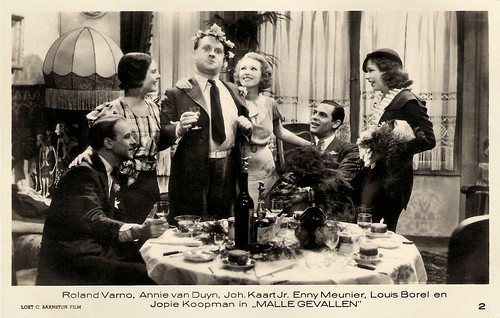
Dutch postcard, no. 2. Photo: Loet C. Barnstijn Film. Publicity still for Malle Gevallen/Silly Situations (1934) with Roland Varno, Annie van Duyn, Johan Kaart, Enny Meunier, Louis Borel, and Jopie Koopman. Collection: Egbert Barten.
Image may be NSFW.
Clik here to view.
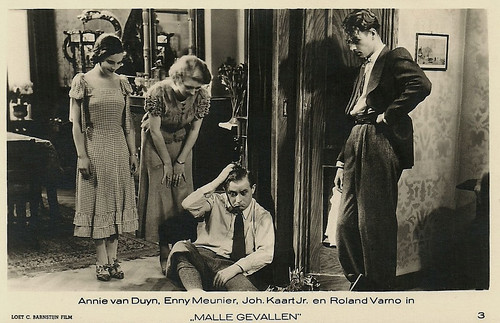
Dutch postcard, no. 3. Photo: Loet C. Barnstijn Film. Publicity still of Annie van Duyn, Enny Meunier, Johan Kaart, and Roland Varno in Malle gevallen (1934).
Three students and three girls
Malle gevallen/Silly situations (1934) was one of the dozens of Dutch sound films, made after the success of the musical De Jantjes/The Tars (Jaap Speyer, 1933). The producer of De Jantjes, film distributor and former cinema operator Loet C. Barnstijn, engaged director Jaap Speyer, who had worked for years in the silent film industry in Berlin and who had directed De Jantjes.
In 1929, Barnstijn had Philips develop the ‘Loetafoon’, his own projection system for sound films. In the few years that followed, he imported sound-film cameras, and was the first person in the Netherlands to produce a short sound film.
Malle gevallen is a romantic comedy written by Hans Martin and Simon Koster based on Martin's 1913 novel. The plot is about three students (Roland Varno, Louis Borel and Johan Kaart Jr.) who are in love with three girls (Enny Meunier, Annie van Duyn and Jopie Koopman).
At the time, Roland Varno (1908-1996) was already known for his role as one of the gymnasiasts in Josef von Sternberg's Der blaue Engel/The Blue Angel (1930). He later worked in Hollywood as a character actor, mainly in B-pictures.
Louis Borel (1905-1973) appeared in films in the Netherlands, in Great Britain and in Hollywood. He also adapted, translated, directed and starred in many stage plays. At the end of his career he became a popular TV star.
Johan Kaart Jr. (1897-1976) starred in seven Dutch films between 1934 and 1937. After the war he played in several other Dutch films. He also worked often for radio and TV, but his main stage was the theatre.
Enny Meunier (1912-1996) was a celebrated stage actress, who also performed on radio and TV. During the 1930s she starred in a few Dutch films.
Stage actress Annie van Duyn (1915-?) played in six films of the 1930s and also in a film after the war. Later she moved to the USA.
Jopie Koopman (1910-1979) was a pretty cabaret artist, who sang and played in several revues and early sound films.
Image may be NSFW.
Clik here to view.

Dutch postcard, no. 4. Photo: Loet C. Barnstijn Film. Publicity still of Roland Varno, Louis Borel, and Johan Kaart in Malle gevallen (1934).
Image may be NSFW.
Clik here to view.
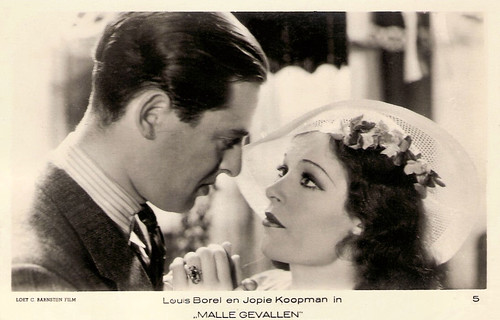
Dutch postcard by M. B.& Z. (M. Bonnist & Zonen, Amsterdam), no. 5. Photo: Loet C. Barnstijn Film. Louis Borel and Jopie Koopman in Malle gevallen (1934).
Image may be NSFW.
Clik here to view.
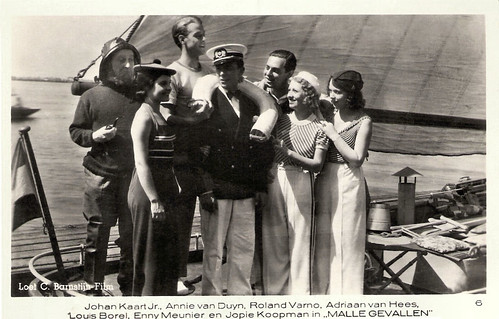
Dutch postcard, no. 6. Photo: Loet C. Barnstijn Film. Publicity still for Malle Gevallen (1934) with Johan Kaart, Annie van Duyn,Roland Varno, Adriaan van Hees, Louis Borel, Enny Meunier and Jopie Koopman. Collection: Egbert Barten.
Image may be NSFW.
Clik here to view.

Dutch postcard, no. 7. Photo: Loet C. Barnstijn Film. Publicity still of Johan Kaart Jr. in Malle gevallen (1934).
Image may be NSFW.
Clik here to view.
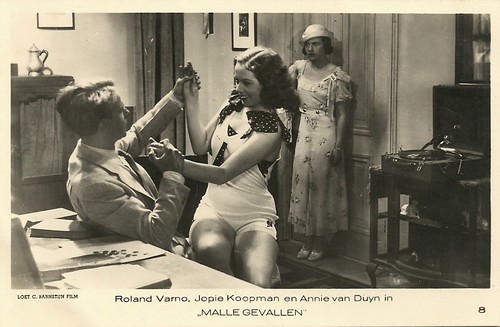
Dutch postcard, no. 8. Photo: Loet C. Barnstijn Film. Roland Varno, Jopie Koopman and Annie van Duyn in Malle gevallen (1934).
Coarseness and bad taste
Malle gevallen/Silly situations (1934) was intended as a light romantic comedy, but it was made into a musical with songs by orchestra leader Max Tak. Although scriptwriters Martin and Koster wanted to make something sophisticated, the final result was a farce. The famous film critic L.J. Jordaan complained about the "coarseness and bad taste" in the film.
Nevertheless, the film was a commercial success. The film was regularly shown in the Dutch cinemas until it was banned in 1942 by the Nazis. Why the Nazis forbade the film is still unknown.
In 1935, Loet C. Barnstijn released De familie van mijn vrouw/The family of my wife (Jaap Speyer, 1935) with Sylvain Poons. That same year he bought the Oosterbeek Estate near Wassenaar and built two film studios. He called this Filmstad (Film City). It consisted of an office, a storage film, a recording studio and a technical workshop.
This studio produced the successful film Merijntje Gijzen's jeugd/Merijntje Gijzen's youth, based on the novels by A.M. de Jong. When World War II broke out, Barnstijn stayed in the United States because of his Jewish background. The film studios of Oosterbeek were confiscated by the German film company Ufa and were later destroyed during an air raid. Barnstijn died in the USA in 1953.
In 2007, the Dutch Filmmuseum presented a DVD of Malle gevallen.
Image may be NSFW.
Clik here to view.

Dutch postcard by M. B.& Z. (M. Bonnist & Zonen, Amsterdam), no. 9. Photo: Loet C. Barnstijn Film. Roland Varno and Enny Meunier in Malle gevallen (1934).
Image may be NSFW.
Clik here to view.

Dutch postcard by M. B.& Z. (M. Bonnist & Zonen, Amsterdam), no. 10. Photo: Loet C. Barnstijn Film. Roland Varno and Enny Meunier in Malle gevallen (1934).
Image may be NSFW.
Clik here to view.

Dutch postcard, no. 11. Photo: Loet C. Barnstijn Film. Publicity still for Malle Gevallen (1934) with Roland Varno, Johan Kaart, Annie van Duyn, Louis Borel, Jopie Koopman and Enny Meunier. Collection: Egbert Barten.
Image may be NSFW.
Clik here to view.

Dutch postcard, no. 12. Photo: Loet C. Barnstijn Film. Publicity still for Malle Gevallen (1934) with Louis de Bree.
Image may be NSFW.
Clik here to view.
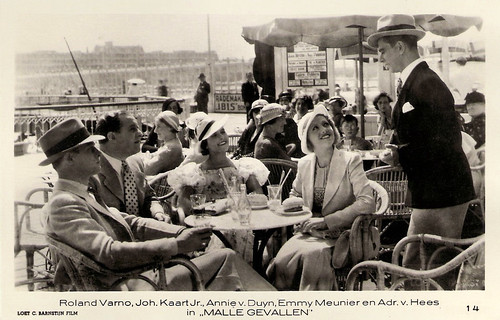
Dutch postcard, no. 14. Photo: Loet C. Barnstijn Film. Publicity still for Malle Gevallen (1934) with Roland Varno, Johan Kaart,Annie van Duyn, Enny Meunier and Adriaan van Hees. Collection: Egbert Barten.
Sources: Eye (Dutch), Wikipedia and IMDb.